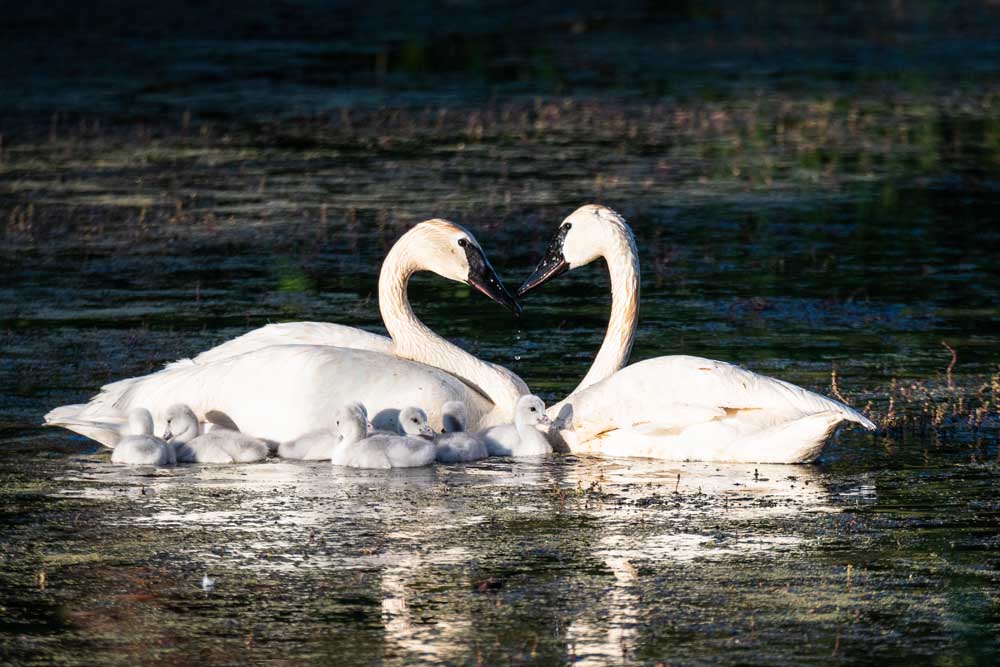Baby trumpeter swans may make 2019 breeding season the best in recent years
Published 12:00 am Sunday, July 14, 2019

- In this 2019 file photo, trumpeter swans Pete and Eloise are seen at the Aspen Lakes Golf Course in Sisters.
The four baby trumpeter swans at the Sunriver Nature Center are not the only ones to hatch this year in Oregon.
Across the state, biologists count 17 baby swans this breeding season, the same number as last year. But there are at least four other nests with eggs that could hatch, potentially making this the most successful breeding season in recent memory. The increase is a sign the species is recovering from being hunted to near-extinction around the turn of the 20th century, when no swans remained in Oregon. Today, about 35 trumpeter swans live year-round in Oregon.
“This is entirely what we hoped for. We just hope there is more of it,” said Marty St. Louis, manager of the Summer Lake Wildlife Area, a 19,000-acre wetland in central Lake County that gives the domesticated swans a chance to live in the wild.
In recent years, the Central Oregon population has suffered several setbacks from illegal hunting, coyotes and even lightning strikes that have killed beloved swans that are critical to the state’s breeding program.
The program is trying to help repopulate the state by monitoring swan pairs in protected areas at the Sunriver Nature Center, Aspen Lakes Golf Course in Sisters and the Pronghorn Resort northeast of Bend.
The offspring from those pairs are sent to the Summer Lake Wildlife Area. Most migrate away, but the hope is that more choose to make Summer Lake their home, St. Louis said.
In total, the state program has released 119 swans at Summer Lake since 2009. Many of those come from captivity in zoos or the Wyoming Wetland Society, which breeds and supplies swans to wildlife areas around the Western United States.
Summer Lake offers swans a year-round habitat of marshes and lakes.
“We are a pretty stable wintering spot,” St. Louis said. “The swans are telling us that.”
Overall, the goal of the state program is to have at least 15 pairs of breeding wild swans. That would give the population a chance to be self-sufficient without needing to release captive swans.
This breeding season has not yet reached that goal. So far, four pairs have produced the 17 offspring. But the numbers are rising.
In Sisters, the swan pair at the Aspen Lakes Golf Course had eight babies hatch in their nest. The June 10 hatching shocked everyone at the golf course.
“Every time we looked, there were more babies,” said Robin Gold, a wildlife rehabilitation expert who lives in the Aspen Lakes neighborhood. Eight offspring is a near record for trumpeter swans. The known record is nine, Gold said.
The Sisters pair, Pete and Eloise, were introduced to each other last year and had one offspring.
“Nobody expected them to go from one to eight,” Gold said. “It was a big surprise.”
While the Sisters pair is new to the state breeding program, Sunriver Nature Center has been a part of the program since 2015, when resident swan Chuck was introduced to Gracie.
Chuck and Gracie became a crucial part of Oregon’s repopulation effort. The pair produced six offspring — two in 2016 and four in 2017.
But on Thanksgiving Day 2017, Chuck was illegally shot and killed by a young man who was duck hunting on the Deschutes River northwest of Sunriver.
It wasn’t the first time Gracie was affected by illegal hunting.
In October 2016, a hunter shot and killed two swans at Summer Lake. One of them was Fiona, an offspring of Chuck and Gracie, who had only been there a few months. The other swan, Hope, who later died in surgery, was the first cygnet hatched in the wild at Summer Lake to reach adulthood.
Losing Hope and Fiona was a huge blow to the state reintroduction effort. A key to the state program is getting swans like Fiona and Hope to reach adulthood and raise offspring in the wild. Surviving until adulthood is difficult for swans even without the threat of illegal hunting, said Gary Ivey, past president of the Trumpeter Swan Society and former biologist at Malheur National Wildlife Refuge.
Young swans are vulnerable to predators, such as coyotes and bobcats.
“You lose about half of the young the first year,” Ivey said.
Fiona has a sibling, which could produce offspring next year, Ivey said.
Ivey wants to see the sibling, and other young swans that hatched in recent years, reach the breeding age of 4, when they can start raising offspring in the wild.
“Next year and the year after we should start to see some of those birds start nesting,” Ivey said. “I hope next year is a big boon year.”
Trumpeter swans are the largest native waterfowl in North America. Their wingspan can reach 7 feet, and they can weigh up to 30 pounds. They can live up to 30 years.
A closer look at a trumpeter swan reveals three sharp claws on each of its webbed feet and a large wrist bone on its wings that can be used to punch when threatened.
Despite the recent troubles with the Oregon swan population, this breeding season is giving biologists hope.
An especially positive sight came in Sunriver on the Fourth of July, when four fuzzy heads appeared from the nest of Gracie and her new mate, Gus, who was transported from a Michigan sanctuary in May.
Sunriver Nature Center staff were amazed since it had been exactly two years since Gracie hatched four babies on the Fourth of July. The odds of that happening twice in two years is staggering for the staff. But the staff has learned never to doubt Gracie.
“She is a bit of a supergirl in our eyes,” said Amanda Accamando, nature center manager.
Two days after the four baby swans hatched, the nature center hosted about 700 people for its annual Wildflower Show & Pollinator Festival. Visitors came for the flowers, but couldn’t help noticing the new swan family.
“People are really feeling content,” Accamando said. “They are just so happy to see the last two years are wrapping up in such a joyous way.”
— Reporter: 541-617-7820, kspurr@bendbulletin.com






